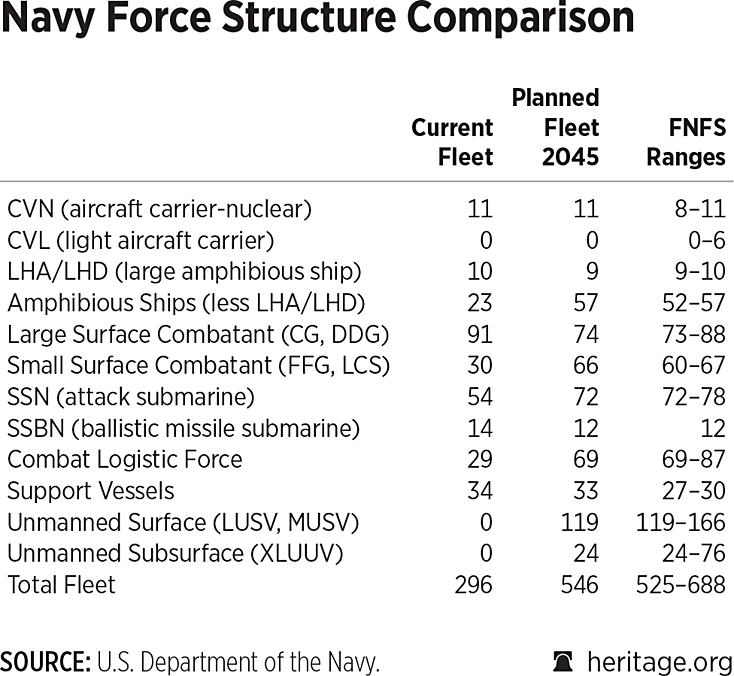The Issue
On December 9, 2020, the U.S. Navy released its Annual Long-Range Plan for Construction of Naval Vessels, focusing on great-power competition, for fiscal year (FY) 2022 to FY 2051. By itself, this plan is inadequate; it details neither fleet employment nor needed industrial base expansion. Moreover, the plan does not inform the FY 2021 National Defense Authorization Act.
The Naval plan promises a manned fleet of 355 ships three years earlier than the current plan, while deliberately phasing in unmanned ships to the fleet, eventually reaching more than 400 manned ships by 2045. However, it does not provide for building—and then sustaining—a logistics fleet to meet current and anticipated needs. Unless the Navy can champion this plan successfully, building the needed fleet will be questionable given an accelerating naval competition with China and Russia.
BACKGROUND
- The plan’s release was delayed for nine months to allow the Secretary of Defense to conduct a Future Naval Force Study (FNFS) that analyzed the Navy’s competitive advantage over China and Russia through 2045; the recommended fleet is known as Battle Force 2045.
- The Navy’s last fleet analysis was the 2016 Force Structure Assessment, which then concluded that meeting Combatant Commanders’ requirements necessitated 653 warships, later reduced to 459 ships, once redundancies were removed. For cost reasons, the goal was reduced to 355 warships by 2034; at the time, the Chinese navy consisted of more than 300 warships.
- As of September 2020, the Defense Department assesses that the Chinese navy consists of 350 warships and is ahead of the U.S. in shipbuilding. The Defense Department anticipates that China’s navy will grow to more than 425 warships by 2030, and the Center for Naval Analysis predicts that Russia will focus on modernizing and sustaining approximately 73 blue-water warships.
SUSTAINED MODEST BUDGET GROWTH REQUIRED UNTIL 2045
- The plan assumes 2 percent real growth in shipbuilding budgets above 2.1 percent inflation from 2021 to 2051; it prioritizes near-term readiness recovery and establishing a credible forward presence.
- The plan adds unmanned platforms starting in FY 2023, for a total unmanned force of 21 vessels by FY 2026 (6.6 percent of the fleet), growing to 143 vessels (26 percent) by 2045.
- The plan prioritizes sustaining undersea advantage and expands nuclear undersea shipbuilding industrial capacity investing to $1.7 billion from FY 2022 to FY 2024.
- In FY 2023, the Navy intends to select a “follow yard” for expanding Constellation-class frigate construction to an annual production rate of four ships a year by FY 2025.
- Sealift transports 90 percent of military needs in war, and sealift ships have an average age of 40, with half reaching the end of their service life by 2030. The Navy has developed a plan to purchase used commercial ships to meet a required inventory of 83 ships by FY 2026, which the current plan does not sustain after FY 2029.
- Current budget estimates for sustainment of operations and support (O&S) costs do not include the cost for sustaining unmanned platforms, due to insufficient data.
- Shipbuilding budgets grow from $22 billion (FY 2022) to $33.6 billion (FY 2026), then drop to $22 billion (FY 2029), gradually returning to $32 billion in FY 2043; meanwhile, O&S budgets more than double to more than $70 billion by FY 2040.
OUTSTANDING ISSUES
- Final force sizing is dependent on development of several new platforms, notably:
- A Combat Logistics Force that includes increasing the number of fleet-replenishment oilers (T-AOs) and developing a smaller oiler known as Next Generation Logistics Ships (NGLS) slated to begin production in FY 2023.
- Development of NGLS and the Light Amphibious Warship, planned to begin production in FY 2022, will inform planned construction dependent on the Marine Corps’ evolving dispersed concept of operations.
- A carrier aviation study to assess missions, and a mix of traditional nuclear aircraft carriers and a future light aircraft carrier.
- The Navy is assessing how to execute this plan while overcoming capacity limits to produce three nuclear-attack submarines per year without affecting next-generation Columbia-class nuclear-ballistic-missile-submarine production past FY 2026.

CHALLENGES AHEAD
- Unless shipbuilding rates are sustained beyond FY 2026, it is unlikely that budget predictability, design stability, and build intervals will be achieved, which means that it is unlikely that needed domestic maritime industry capacities will be increased.
- The FNFS stipulates significant growth in the Navy’s nuclear fleet, placing added strain on the existing four public shipyards, which if not addressed, risks future at-sea time due to delayed maintenance. Not mentioned in the FNFS is the associated growth in the 20-year, $21 billion Shipyard Infrastructure Optimization Plan.
- An increasing percentage of the fleet will consist of unmanned platforms, likely mitigating, but not alleviating, the Navy’s need for more highly trained personnel.



